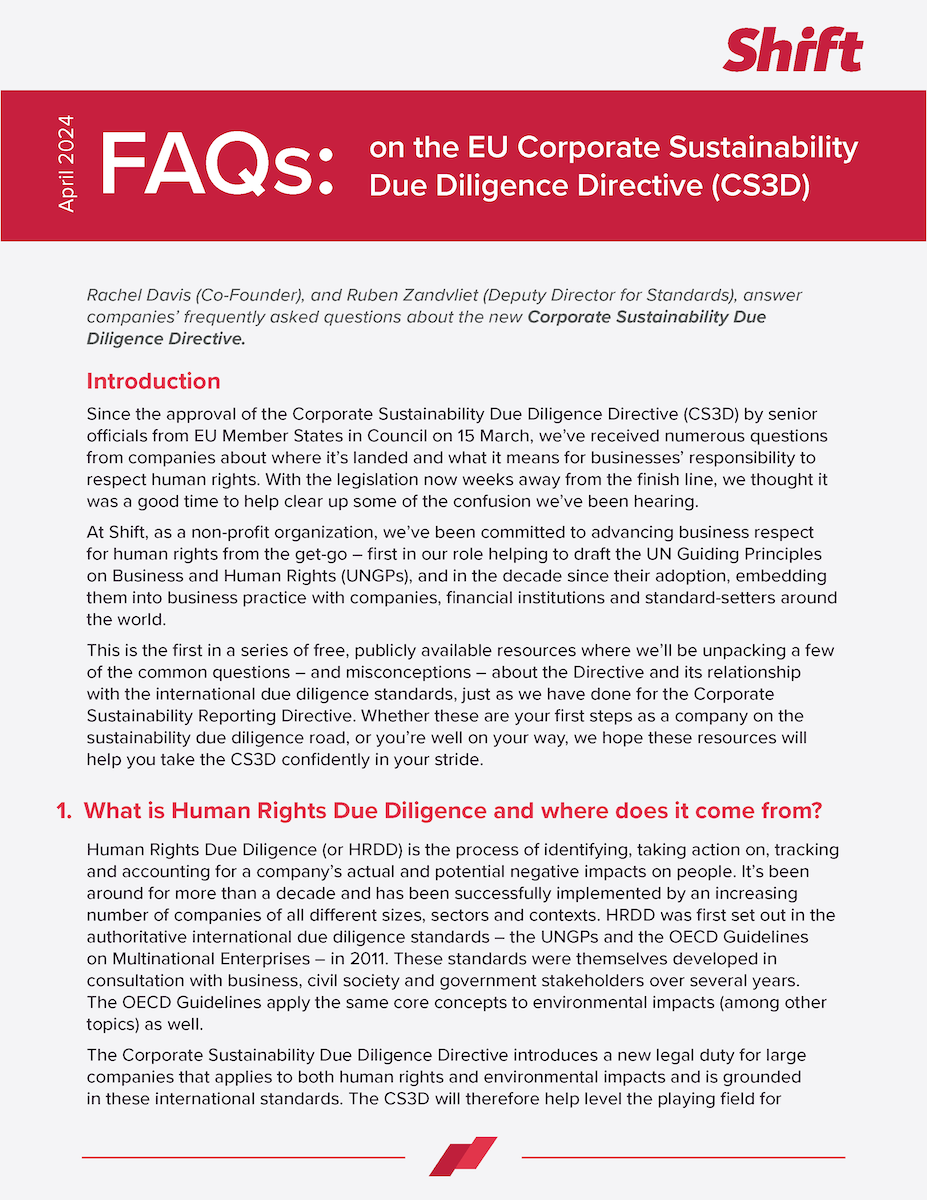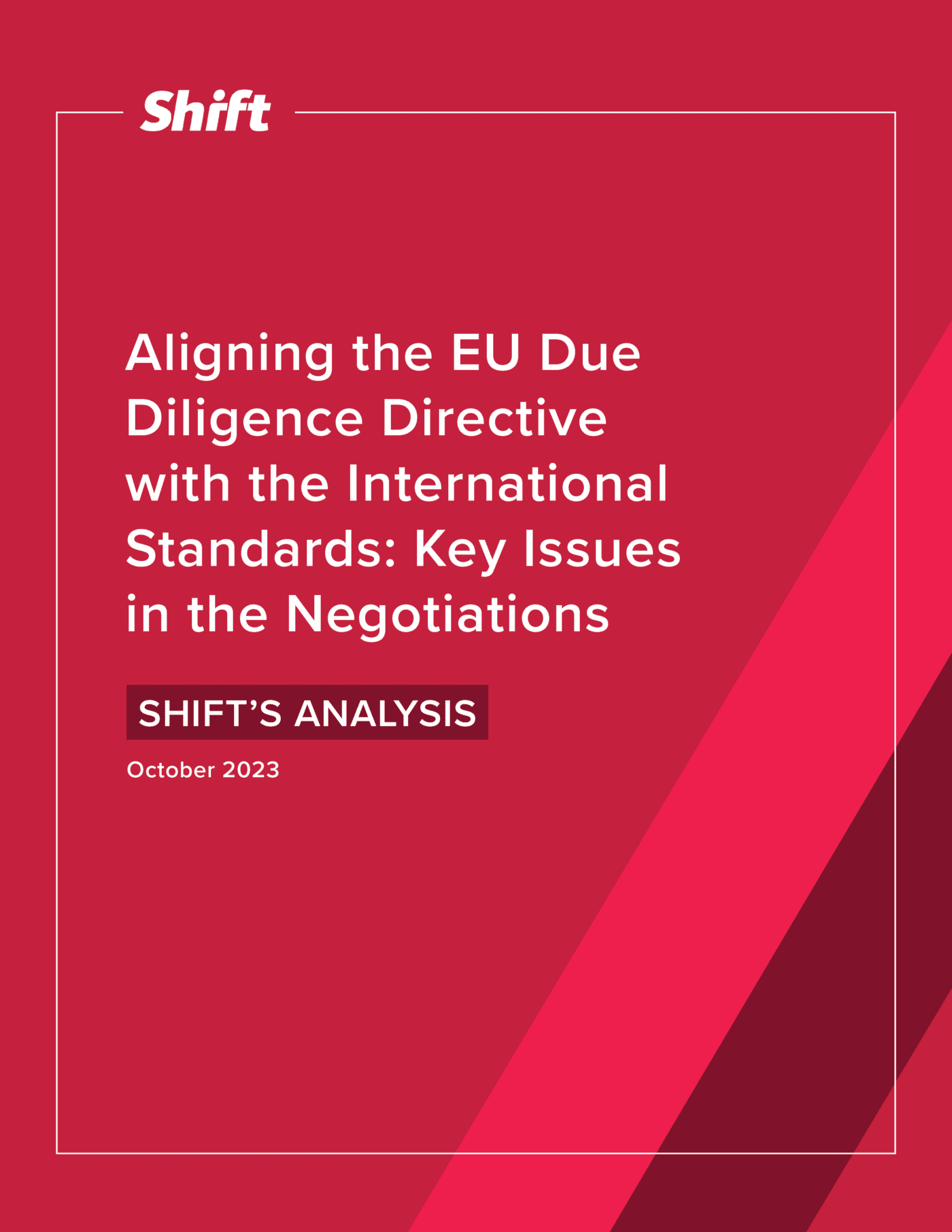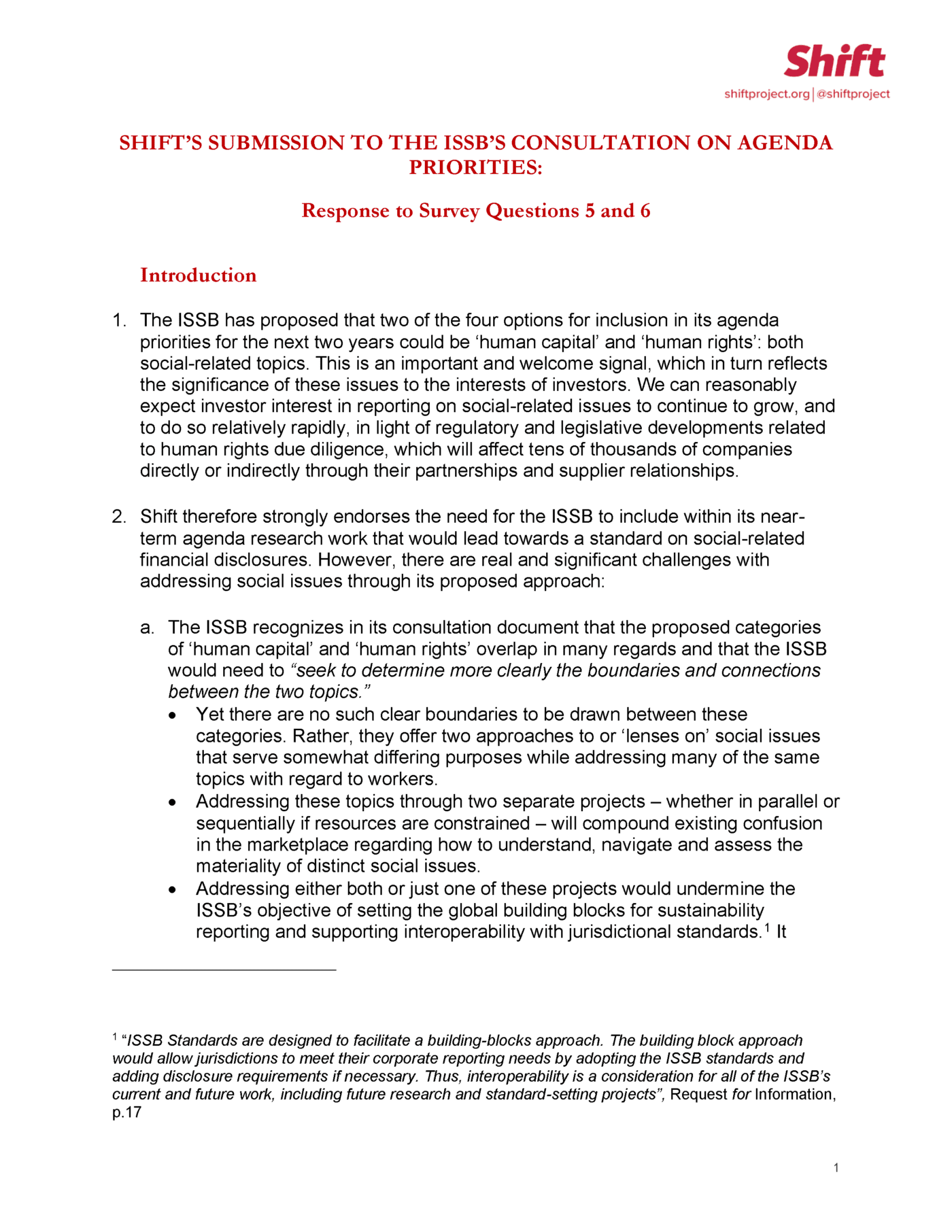Today in 2021, there should be little need for a discussion on whether human rights and the environment are intrinsically connected. The question is rather, how can businesses best address risks to people and planet in a holistic way and how can the policy environment enable this transition?
The question is rather, how can businesses best address risks to people and planet in a holistic way and how can the policy environment enable this transition?
Companies operating today can no longer treat their climate, other environmental and human rights risks in silos: there are too many interconnections between these areas for this approach to work. Rather, what we need is for companies to be empowered, equipped and incentivized to adopt a comprehensive sustainability approach to risks to people and to the planet. The upcoming EU legislation under the Sustainable Corporate Governance Initiative offers a golden opportunity to design a due diligence structure to do just that. And importantly, there are already examples of harmonized due diligence that can serve as a foundation on which new legislation can build.
Here we offer some key reflections that we believe can help inform a harmonized due diligence obligation.
We have applicable international frameworks already
The UN Guiding Principles on Business and Human Rights (‘UNGPs’) provide a clear and authoritative reference point for what is expected of companies when it comes to human rights due diligence. The OECD Guidelines for Multinational Enterprises (‘OECD Guidelines’) echo the UNGPs’ expectations on human rights and extend the due diligence framework set out in the UNGPs to environmental impacts and risks (as well as other relevant risks). An overarching 'sustainability due diligence' (This term draws on a research-based concept of sustainable value creation within planetary boundaries, as described further in the SMART project’s reform proposals for EU company law and corporate governance.) framework should clearly build on these soft law due diligence standards and methodologies, and create further connections and synergies between them.
An overarching ‘sustainability due diligence’ framework should clearly build on these soft law due diligence standards and methodologies, and create further connections and synergies between them.
Companies navigate the relationship between international expectations and national requirements in both areas
In the area of human rights, companies are expected (under the UNGPs and OECD Guidelines) to look at internationally recognized human rights standards set out in core UN and ILO instruments which inform their due diligence approach and define the baseline against which they assess their impacts on people.
National laws also regulate human rights: they may compel company actions in a range of areas, such as discrimination, labor arrangements and health and safety. However, if these standards fall below, or conflict, with international standards, companies are still expected to meet, or seek to meet, international standards. Notably, the UNGPs expand these expectations to the company’s business relationships, whereas applicable law typically focuses on the company’s own operations.
We find a similar picture when looking at the environmental side. Companies are expected under the OECD Guidelines to take due account of the need to protect the environment – referencing in turn principles and objectives contained in international agreements. Similarly, companies can rely on national environmental laws, but this is often insufficient on its own to meet international environmental expectations of business – and, again, may not extend beyond the company’s operations.
Of particular note, a recent court case in the Netherlands held an energy company (Royal Dutch Shell) to international climate standards (the 2015 Paris Agreement) rather than to national standards. The court also relied on international expectations contained in the UNGPs, rather than applicable national law, to conclude that the company had a responsibility for scope 3 emissions, beyond its own operations.
In both areas then, companies are increasingly accustomed to navigating international and national standards.
In both areas then, companies are increasingly accustomed to navigating international and national standards. On the environmental side however, and in contrast to the human rights side, there is no comprehensive body of international standards on the protection of the environment. This can be addressed by EU regulators defining the adverse environmental impacts that companies should be assessing as part of their due diligence and specifying the key principles of environmental law that companies should have regard to in carrying out their due diligence (such as the precautionary principle).
Growing convergence around the scope of responsibility
Companies are expected to take a full value chain approach to human rights due diligence under the UNGPs and the OECD Guidelines. (This full value chain approach is coupled with a specified method for prioritising impacts within the value chain, as further described below). The scope of due diligence extends to impacts that may be directly linked to their operations, products or services through their business relationships. For environmental due diligence, a similar full value chain approach is expected under the OECD Guidelines. Companies should incorporate both direct and indirect environmental impacts connected to their operations into their due diligence. There is also a growing consensus that individual methodologies used for specific environmental areas (such as water, greenhouse gas emissions and biodiversity) should cover impacts beyond a company’s direct operations and tier one suppliers. Taking a full value chain approach to sustainability due diligence is becoming the expectation.
Not only looking at risks to business – but also risks to people and planet
The risks companies will identify through their due diligence will look different – depending on whether they are viewed from the perspective of people, the planet, or the business.
In the human rights space, companies are expected to look at risks to people from the perspective of those who are or may be affected, using international human rights standards. Similarly, in the environmental space, companies are expected to look at risks to the environment from the planet’s perspective – meaning that they need to consider environmental impacts whether or not they also pose risks to the business. This is where new legislation can provide greater clarity for companies, in defining what would constitute an adverse environmental impact.
Beyond this, by bringing these areas together under one ‘sustainability due diligence’ umbrella, we have the opportunity of more clearly understanding the inter-connections between these impacts.
Beyond this, by bringing these areas together under one ‘sustainability due diligence’ umbrella, we have the opportunity of more clearly understanding the inter-connections between these impacts. For example: impacts on the environment and the climate that, over a longer timeframe, will manifest as impacts on human rights; or impacts on human rights that can be mitigated but in a way that harms the environment in the immediate term. This being said, we also need to ensure that bringing these areas together under one umbrella does not result in the dilution of environmental risks which do not have immediate human rights impacts.
Potential to take a longer term view of risk
One point to consider when looking at environmental and human rights risks together is that companies commonly use different timeframes and geographic locations for assessing them.
Looking at risks to people and planet today will yield a different result than looking at impacts that could occur in a year, in ten years or in a generation’s time.
Looking at risks to people and planet today will yield a different result than looking at impacts that could occur in a year, in ten years or in a generation’s time. The timeframe for assessment of human rights impacts tends to be more immediate, with a focus on human rights impacts that could occur in the short- or medium-term. Due diligence can also include longer-term impacts (e.g. from the future decommissioning of a project or transitions to automation), however, capturing long-term human rights impacts can be a challenge because of limitations in predicting future activities and behaviours. When it comes to environmental impacts, the time horizon for assessing impacts tends to be longer and commonly relies on scientific projection data.
Furthermore, human rights due diligence will typically capture impacts on people close to the company’s site, or those impacted by its suppliers’ operations. Some environmental impacts also have localized impacts on a specific habitat or water source, while others have both cumulative impacts and ripple effects on the environment elsewhere, and/or are global in nature. Where environmental impacts are local, this could more visibly result in local human rights impacts (e.g. impacts on a community’s access to water or sanitation). In contrast, where the environmental impacts manifest elsewhere or are global, this could connect to human rights impacts elsewhere (e.g. communities’ livelihoods impacted by greenhouse gas emissions) – but it is more challenging to identify the specific groups of people affected.
In practice, we are seeing that companies are finding it easier to bring environmental and human rights considerations together under one broader umbrella when both sets of impacts are more localized in nature. New legislation can reflect the differing timelines and locations of where risks may manifest, and help ensure that due diligence enables capturing change over time, both to the risk and to the expected mitigation/action.
Whose views determine which risks to prioritize?
The human rights risks that companies are expected to prioritize for attention are those that pose the greatest potential harm to people. Since human rights risks should be understood from the perspective of those who are or may be affected, the most effective way to conduct due diligence is to conduct stakeholder engagement – with those who could be impacted or their legitimate representatives, or with credible proxies where direct engagement is not possible, as well as with human rights experts. In the environmental space, we are seeing a growing number of companies including elements of human rights-based stakeholder engagement as part of their environmental work – and this is also expected for environmental impacts that result in impacts on people (as evidenced for instance by the European Parliament’s 2020 proposal for an EU legal framework to halt and reverse deforestation).
The opportunity here is to support companies in conducting stakeholder engagement that can inform both their environmental and human rights due diligence, while recognizing where the objectives of, and audiences for, engagement may differ.
The opportunity here is to support companies in conducting stakeholder engagement that can inform both their environmental and human rights due diligence, while recognizing where the objectives of, and audiences for, engagement may differ. Further, engaging on both human rights and environmental risks together can help companies see the interlinkages, develop more nuanced prioritization criteria and methodologies, and inform and explain their prioritization decisions.
What actions is a company expected to take?
The actions that a company is expected to take in response to a human rights impact differs depending on how the company is, or could be, involved with an impact. There are different expectations for action depending on whether a company has caused the impact, contributed to the impact, or whether the impact is directly linked to the company’s operations, products or services by a business relationship. Actions range from ceasing the impact, preventing the impact, building and using leverage (alone or with others) to prevent and/or mitigate the impact (or seeking to do so), and remedying the impact.
Cause and contribution as modes of involvement are also well-known in environmental due diligence. In particular, we often see companies talk about cumulative environmental impacts: how their actions alongside those of other parties can combine to create environmental impacts. This is akin to contribution in parallel, an accepted mode of involvement in the human rights space. The actions expected for instances of cause or contribution are similar to the human rights space: cease, prevent, and/or mitigate the impacts and remedy the contribution.
Although not necessarily framed as such, a number of environmental methodologies expect companies to build and exercise leverage. But there may be some areas of distinction to consider when it comes to remedy. A company’s responsibility to remedy a human rights impact seeks to restore the person to the situation they would have been in, had that impact not occurred, or as close to it as possible. Companies may also be expected to remediate their environmental impacts – with the appropriate remedy being defined by regulation or the applicable international framework. At the same time, when it comes to environmental harm, there may be broader repercussions where environmental degradation has had ripple effects and led to other forms of environmental harm. Where environmental harm results in impacts on people, the remedy expectations of companies are clear. When they have not (or have not yet), the remedy expectations are less clear.
Where environmental harm results in impacts on people, the remedy expectations of companies are clear. When they have not (or have not yet), the remedy expectations are less clear.
A new corporate duty could reinforce the importance of companies using leverage to tackle risks, and articulate what can be reasonably expected of companies in terms of action depending on their mode of involvement with an impact, including what remedy can look like (and to whom it can be delivered) in the environmental space.
Conclusion: Embedding due diligence in governance
As the connections between the ‘E’ and the ‘HR’ of ‘HREDD’ grow, so too will the need for cross-functional structures and discussions that enable companies to take a holistic approach to due diligence. This extends to when companies are setting overarching targets, as well as how they set up their internal accountability and responsibility structures. Synergies should start to happen between functions, budget lines, programming and expertise on these areas within companies. And this in turn will start to inform business models that are viewed as sustainable for the long term – as well as those that are not. New EU regulation can play a pivotal role here in supporting companies to take a holistic approach to sustainability risks, which builds on and amplifies existing methodologies and standards, in a way that is embedded in appropriate governance structures.




